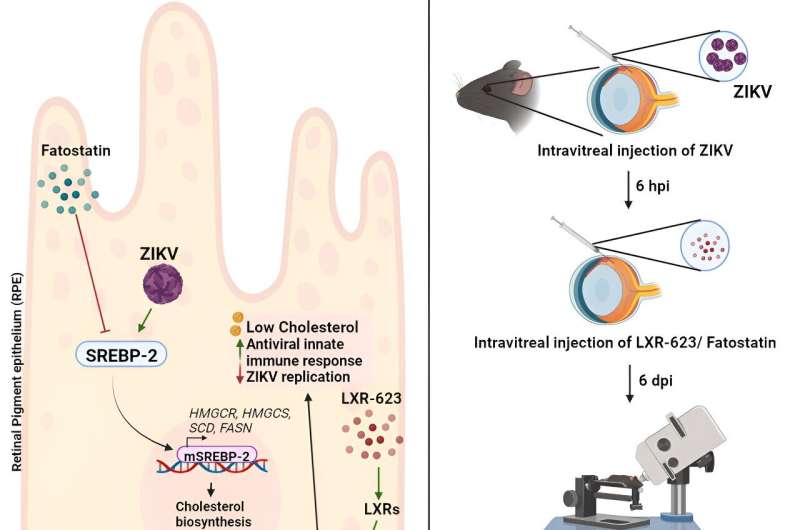This article has been reviewed according to Science X's editorial process and policies. Editors have highlighted the following attributes while ensuring the content's credibility:
fact-checked
peer-reviewed publication
trusted source
proofread
Researchers uncover potential treatment targets for Zika virus–related eye abnormalities

A study published in the journal iScience presents crucial insights into the ocular effects of Zika virus infection during pregnancy and offers promising avenues for therapeutic intervention.
Produced by a team of researchers in the Department of Ophthalmology, Visual and Anatomical Sciences at the Wayne State University School of Medicine, the paper, "Targeting ABCG1 and SREBP-2 mediated cholesterol homeostasis ameliorates Zika virus-induced ocular pathology," provides compelling evidence of the involvement of cholesterol metabolism in ZIKV-related eye abnormalities.
Zika virus, or ZIKV, has emerged as a public health threat and poses significant challenges to reproductive health worldwide. While congenital ZIKV infection has been shown to cause neurological disorders, primarily microcephaly—abnormal shrinking of the head circumference—several clinical studies have linked ZIKV to ocular deformities in infants. These include retinal lesions, microphthalmia, hemorrhagic retinopathy, retinal pigmented epithelium mottling, optic neuritis and hypoplasia of the optic nerve.
Despite the ZIKV infection causing severe neurological and ocular abnormalities in infants, no specific vaccines or antiviral treatments are available. In their research, the team conducted a transcriptomic analysis of ZIKV-infected retinal pigment epithelial (RPE) cells, revealing significant alterations in the cholesterol pathway.
"Our study aimed to uncover the molecular mechanisms underlying ZIKV-related eye abnormalities, with a focus on cellular metabolism," said Ashok Kumar, Ph.D., professor of ophthalmology, visual and anatomical sciences, and senior author of the study. "By elucidating the roles of key players in cholesterol metabolism, we sought to identify potential targets for therapeutic intervention."
The researchers investigated the functional roles of ATP-binding cassette transporter G1 (ABCG1) and sterol response element binding protein 2 (SREBP-2), two critical regulators of cholesterol metabolism, during ocular ZIKV infection. Their cell culture experiments demonstrated that increased ABCG1 activity, mediated via liver X receptors (LXRs), led to reduced ZIKV replication, while inhibition of SREBP-2 reduced viral replication by lowering cholesterol levels.
In vivo studies using mouse models of ZIKV-induced chorioretinal lesions revealed that treatment with an LXR agonist or SREBP-2 inhibitor mitigated ocular abnormalities associated with ZIKV infection. These treatments were accompanied by decreased expression of inflammatory mediators and increased activation of antiviral response genes.
"This study highlights the intricate interplay between cholesterol metabolism and ZIKV infection in the eye," explained Sneha Singh, Ph.D., a postdoctoral fellow in Kumar's lab. "Our findings suggest that targeting cholesterol pathway components, such as ABCG1 and SREBP-2, could offer promising therapeutic strategies for mitigating ZIKV-induced ocular complications."
"The implications of our study extend beyond Zika virus, as the mechanisms uncovered can potentially apply to other enveloped viruses such as West Nile virus, Japanese encephalitis virus and Dengue virus," Kumar said.
Kumar's team is utilizing a lipidomics approach to pinpoint lipid molecules possessing both proviral and antiviral properties, with the overarching goal of unearthing novel antiviral therapeutics.
"Through the innovative research team that Dr. Kumar has established, they are at the forefront of developing breakthroughs that will play a vital role in therapeutic interventions in eye abnormalities caused by the Zika virus," said Ezemenari M. Obasi, Ph.D., vice president for research at Wayne State. "This study is an excellent example of how Wayne State's research is making discoveries that can impact lives in Detroit and around the world."
More information: Sneha Singh et al, Targeting ABCG1 and SREBP-2 mediated cholesterol homeostasis ameliorates Zika virus-induced ocular pathology, iScience (2024). DOI: 10.1016/j.isci.2024.109088



















